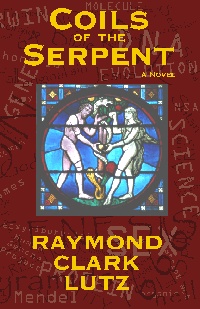“What’s
this ‘point’ you say we’re missing?” Dan
asked intently, surprised by the challenge of the bearded vagabond.
The man leaned
toward the group and cleared his throat again. “Well, you say
it’s a fact that DNA and the details of life are the same for
all life, right?”
“Absolutely.” Shannon
set her coffee down and picked up the stirring stick again; she waved
it as she talked. “There’s no debate about that.
Scientists are amazed at the uniformity among—”
“Well then,” the
stranger interrupted, “is it also true that throughout history,
life used exactly the same pattern? For example, were the humans of
six thousand years ago also based on DNA and cells like we have
today?”
“Without a doubt,”
Shannon answered. “Mummified remains from Egypt are at least
that old. They’ve recently recovered DNA from Neanderthals,
perhaps 30,000 years old. I understand that DNA may have been
recovered from bones of a prehistoric animal—perhaps a
dinosaur—from an 1,800-foot-deep coal mi—”
“Surface,” he
grunted. “You’re just talking on the surface. You’ve
got to dig in. Push your discussion deeper.” He dug his hands
into the air before him as if he were scooping out a hole.
The three friends
scanned faces and waited for him to continue.
Wasn’t our
discussion already deep? What does this guy mean? Dan thought.
Shannon didn’t
say anything. She apparently thought 1,800 feet was already deep
enough.
The stranger stroked
his heavy beard. “Let me start with a simple question: Would
God understand DNA? Would God understand this uniform underlying
pattern of life?”
Oh great, a
homeless beach preacher, just what we need, Dan thought.
“Okay, that’s easy,”
John said, without delay. “Of course he would. God created the
universe, earth, and all life. He would obviously know everything
about DNA and how biology works. Indeed, since all life is built on
this one pattern, I think it proves a single source of creation, the
intelligent design of a single creator.”
“Wait...” Shannon
held up the red plastic stirring stick to make her point. “This
single pattern—it’s more likely the result of evolution
from a single primordial life form. God could have used many
patterns. Why use only one? Why would an unlimited God be limited to
only one pattern? Evolutionary theory is much more strongly supported
by this simple question.”
“Shannon, we all know we’ll
never agree on this,” John said in a condescending voice.
“Let’s try to answer this guy’s question and not
get sidetracked, okay? If you accept that God exists, he would
obviously understand DNA, right?”
“Okay, John, fine.”
Shannon was abrupt. “Look, if you assume that God created life
and knows all about it, then God would obviously know all about it.
If he knows it, then he knows it. That’s what logicians call a
‘tautology’—a definition that simply proves itself.
It’s worthless!”
This introduction of
religion into their otherwise peaceful conversation delineated a war
zone between Shannon and John. Dan began to worry that this normally
taboo topic would ruin the three-way friendship and bonding the group
had developed since they first met at the book club meeting.
Dan wanted to find
some middle ground. “Consider this: In spite of all our
scientific understanding, the basic forces of nature are still quite
mysterious; we have to agree on that. For example, magnetic fields
can be defined and mathematically described to great detail—we
have cell phones, radios, TVs—but scientists really don’t
know how such invisible fields can exist. They just do. Gravity is
even more baffling. We are subject to its constant influence, but we
don’t know how it works. We can’t manipulate the gravity
field at all—at least, not yet. There are no anti-gravity cars
or gravity lenses, or anything like that.
“Even though we don’t
really know how they can exist, these basic forces define how our
world works. If evolution is factual, it also complies with these
basic laws of nature, even if the ultimate source of those forces is
unknown. Evolution doesn’t explain why these underlying laws of
nature exist, but it must still conform to those laws. I can
understand how a reasonable person can rely on God as the creator of
these invisible forces while still embracing the theory of evolution.
It’s not too hard.”
“Since we have complete
agreement on that question, let’s move on.” The stranger
smirked, but beneath his cap his eyes twinkled. “You can
believe what you want, but let’s assume, for sake of discussion
at least, that there is a god—a creator. God would obviously
understand DNA and the secrets of biological mechanisms; that seems
simple enough. But that’s not really the question I was talking
about.” His eyes grew serious as he held their gaze.
“The question, my friends,
is simply this: Are these biological facts ever described by sacred
literature? For example, have you ever seen any mention of DNA and
the basic pattern of life in the Bible?”
The room grew quiet.
Ceiling fans turned slowly above their heads and the red second-hand
of the clock on the far wall ticked off the seconds one by one.
Dan looked beneath
the man’s worn bill into clear, youthful eyes surrounded by
wrinkles that hinted of a wealth of experience. His full, graying
beard effectively concealed most of the rest of his face. This
can’t be just a homeless vagrant. Maybe he’s an
ex-professor whose life was ruined by the bottle.
“Well, you pose a very
interesting question, my friend, but we don’t even know your
name. My name is Dan.” He shook hands with the stranger.
“Hello, I’m Walker.”
“Pleasure.” Walker’s
somewhat soiled hand fit comfortably with Dan’s, and he had an
unusually disarming and solid handshake.
